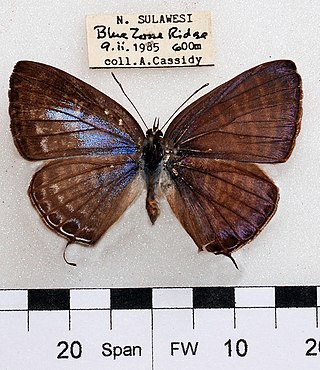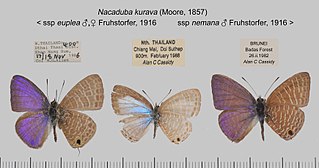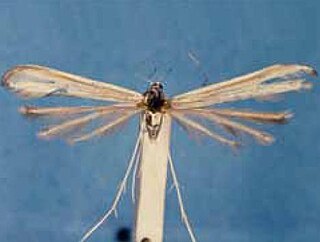
The Marquesas Islands are a group of volcanic islands in French Polynesia, an overseas collectivity of France in the southern Pacific Ocean. Their highest point is the peak of Mount Oave on Ua Pou island, at 1,230 m (4,035 ft) above sea level.

The meadow brown is a butterfly found in the Palearctic realm. Its range includes Europe south of 62°N, Russia eastwards to the Urals, Asia Minor, Iraq, Iran, North Africa and the Canary Islands. The larvae feed on grasses.

Jamides celeno, the common cerulean, is a small butterfly found in Indomalayan realm belonging to the lycaenids or blues family. The species was first described by Pieter Cramer in 1775.

Nacaduba pactolus, the large four-line blue, is a species of lycaenid butterfly found in Indomalayan realm.

Nacaduba kurava, the transparent six-line blue, is a species of butterfly in the family Lycaenidae found in Asia and Australia. The species was first described by Frederic Moore in 1857.
Chrysophyllis is a genus of the grass moth family (Crambidae). It is monotypic, containing the single species Chrysophyllis lucivaga. This moth is very little known, having only been recorded once, before 1935. It belongs to the large grass moth subfamily Spilomelinae; at the time of its description, these were still included in subfamily Pyraustinae and the entire Crambidae was then merged with the snout moths. While its exact relationships are undetermined, it is believed to be a close relative of Talanga. Like these, the male genitalia of C. lucivaga feature a remarkably elongated aedeagus shaped like a bullwhip.
Marasmianympha is a genus of moths of the grass moth family (Crambidae) described by Eugene G. Munroe in 1991. Its single species, Marasmianympha eupselias, was described by Edward Meyrick in 1929. Among the grass moths, it belongs to subfamily Spilomelinae. It is endemic to the Marquesas Islands of Polynesia, where it has been recorded on Fatu Hiva, Hiva Oa and Tahuata, but is suspected to occur on other islands as well. The holotype specimen is in the Natural History Museum, London.
Tessema sensilis is a little-known moth species, the only member of genus Tessema. It belongs to the grass moth family (Crambidae), and therein to the large subfamily Spilomelinae; at the time of its description, these were still included in subfamily Pyraustinae and the entire Crambidae was then merged with the snout moths. While its detailed relationships are undetermined, it may be a close relative of Herpetogramma and/or Pilocrocis.

Micropterix aglaella is a species of moth belonging to the family Micropterigidae.It is found in southern France, south-western Switzerland and northern Italy.
Clarkeophlebia is an enigmatic and almost-unknown gelechioid moth genus. It contains a single species, Clarkeophlebia argentea, and is apparently endemic to Fatu Hiva in the Marquesas Islands of Polynesia. It was originally described as Acanthophlebia, but this name had earlier been given to a genus of prong-gilled mayflies.
Herlinda is a genus of cosmet moths. These moths were only discovered in 1968 and the genus was not described until 1986; its affiliations within the family are presently unknown. This genus, as far as is known, is endemic to the Marquesas Islands of Polynesia, with each species confined to a single island.
Phereoeca allutella, the household case-bearing moth, belongs to the subfamily Tineinae of the fungus moth family (Tineidae). It was first described by Hans Rebel in 1892. It is an occasional pest of furs, flannel and similar materials, and has been inadvertently introduced to many places it is not originally native to.

Erechthias simulans is a species of fungus moth. It is here considered to belong to the somewhat controversial type genus of its subfamily Erechthiinae, though even fairly recently some authors have proposed to retain other genera such as Decadarchis separate from Erechthias. Decadarchis, with E. simulans as type species, would in fact contain this moth and its closest relatives, regardless whether it is recognized as full genus or as subgenus. These relatives are generally held to be a group of mainly Polynesian species. E. simulans has also been mistaken for a species of the closely related genus Comodica; while the delimitation of this versus Erechthias/Decadarchis is not universally agreed upon, E. simulans is not included in Comodica anymore by modern authors.

Diaphania indica, the cucumber moth or cotton caterpillar, is a widespread but mainly Old World moth species. It belongs to the grass moth family, and therein to the large subfamily Spilomelinae. This moth occurs in many tropical and subtropical regions outside the Americas, though it is native to southern Asia; it is occasionally a significant pest of cucurbits and some other plants.
Epicephala spinula is a moth of the family Gracillariidae, one of the most primitive groups of ditrysian "micromoths". Within its family, it belongs to the subfamily Gracillariinae. Even though it was first scientifically studied in 1929, for many decades the specimens of this moth were mistaken for the related Australian species E. colymbetella, and their distinctness was only realized in 1986. It is found on the Marquesas Islands, where it occurs at least on Nuku Hiva, Ua Pou, and Fatu Hiva, and though little-known it is apparently not uncommon. The holotype specimen, a female, is USNM 100839.

Merulempista digitata is a moth of the family Pyralidae. It is known from China.

Mompha langiella is a moth of the family Momphidae. It is found in most of Europe, except parts of the Balkan Peninsula and the Mediterranean islands.

Hellinsia agraphodactylus is a moth of the family Pterophoridae. It is found in the Dominican Republic. Records from North America are probably a misidentification.
Stangeia distantia is a moth species of the family Pterophoridae. It was first described in 1986 by J. F. Gates Clarke, and is known from Fatu-Hiva in the Marquesas Archipelago.
Gonionota determinata is a moth in the family Depressariidae. It was described by Clarke in 1964. It is found in Guyana and Venezuela.









